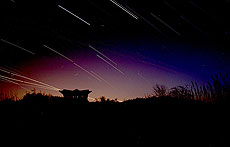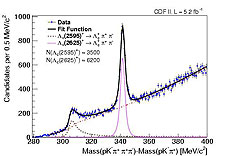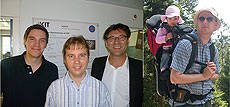|
Thursday, July 21
- Breakfast: Apple sticks
- Tomato Florentine
- BBQ pork sandwich
- Smart cuisine: Kielbasa & sauerkraut
- Smart cuisine: Chicken marsala
- Smoked turkey melt
- Assorted sliced pizza
- Southwestern chicken salad w/ roasted corn salsa
Wilson Hall Cafe Menu
|
|
Friday, July 22
Dinner
Closed
Wednesday, July 27
Lunch
- Six-cheese & bacon stuffed shells
- Garden herb salad w/ roasted shallot vinaigrette
- Fresh fruit plate
Chez Leon Menu
Call x3524 to make your reservation. |
|
Fermilab experiment discovers a heavy relative of the neutron
Scientists of the CDF collaboration at the Department of Energy’s Fermi National Accelerator Laboratory announced the observation of a new particle, the neutral Xi-sub-b (Ξb0). This particle contains three quarks: a strange quark, an up quark and a bottom quark (s-u-b). While its existence was predicted by the Standard Model, the observation of the neutral Xi-sub-b is significant because it strengthens our understanding of how quarks form matter. Fermilab physicist Pat Lukens, a member of the CDF collaboration, presented the discovery at Fermilab on Wednesday, July 20.
The neutral Xi-sub-b is the latest entry in the periodic table of baryons. Baryons are particles formed of three quarks, the most common examples being the proton (two up quarks and a down quark) and the neutron (two down quarks and an up quark). The neutral Xi-sub-b belongs to the family of bottom baryons, which are about six times heavier than the proton and neutron because they all contain a heavy bottom quark. The particles are produced only in high-energy collisions, and are rare and very difficult to observe.
Read more
|
Fermilab-University investigators receive $225,000 in collaborative seed grants
From the University of Chicago newsroom, July 19, 2011
Three teams of University of Chicago and Fermi National Accelerator Laboratory researchers recently received $225,000, collectively, in Strategic Collaborative Initiative (SCI) seed grants following a rigorous competition managed by Fermilab and the University.
The SCI program, begun in 2005 when the University renewed its contract with the U.S. Department of Energy to manage Argonne, encourages intellectual synergies that support the strategic objectives of both institutions. The program funds not only collaborative research projects, but also strategic joint appointments, and joint institutes. The University extended the program to Fermilab when it became co-manager of the laboratory in 2006.
The 2011 Fermilab-University recipients include:
Title: Simulating the Universe with Realistic Physics
University of Chicago Investigator: Andrey Kravtsov, Associate Professor, Astronomy and Astrophysics
Fermilab Investigator: Nickolay Gnedin, Scientist I, Theoretical Astrophysics Group
Title: Understanding Ultrahigh Quality Factor Accelerator Cavities in the Quantum Regime
University of Chicago Investigator: David Schuster, Assistant Professor, Physics
Fermilab Investigator: Lance Cooley, Scientist, Superconducting Materials Department
Title: A New Photodetection System for PET Imaging Using Silicon Photomultipliers
University of Chicago Investigator: Chin-Tu Chen, Associate Professor, Radiology
Fermilab Investigator: Erik Ramberg, Scientist II, Particle Physics Division
Read more
|
Time-lapsed sky over Tevatron
 |
|
Shortly after nightfall on June 28, stars streaked the sky above the gazebo in the center of the Tevatron ring. Photo: Jeff Simmons, AD. |
|
Fermilab announces new particle discovery
From the Kane County Chronicle,
July 21, 2011
Scientists at Fermilab’s Tevatron particle collider on Wednesday voiced excitement about the observation of a new particle.
“It’s a little like looking at the periodic table of elements and finding a missing element,” said Fermilab physicist Pat Lukens, who gave a lecture Wednesday on the discovery. “It’s a particle that we expected to exist so it’s not a surprise, but it is the first observation of its type.”
Lukens is part of the CDF collaboration at Fermilab. The CDF is home to the Tevatron particle accelerator, which accelerates protons and antiprotons close to the speed of light, and then makes them collide head-on inside the CDF detector.
The new particle, the neutral Xi-sub-b, contains three quarks: a strange quark, an up quark and a bottom quark. Lukens said the observation of the particle is significant because it strengthens scientists’ understanding of how quarks form matter.
“It’s a baryon,” Lukens said. “A common example of baryons are protons and neutrons.”
He said the discovery marks just another accomplishment for the Tevatron, which is set to shut down this year after losing out on additional federal funds to continue its operation. The top quark was discovered at the Tevatron in 1995.
It is the heaviest known elementary particle observed in nature.
Read more
|
|
The charm of high-statistics data samples
 |
The distribution of the difference between the reconstructed masses of the studied particles
(Λc(2595) and Λc(2625)) and the Λc ground state obtained from data, together with the fit function. |
There are six types of quarks, and studies of the transitions among them provide important insight to the basic principles of nature. But nature does not provide free quarks. They are always bound by the strong interaction into a pair (a quark and an anti-quark), or into collections of three quarks. The three-quark states are referred to as baryons, the nucleons being the lightest and most prominent representatives of them. Heavier versions of the nucleons contain a bottom or charm quark. They are collectively called heavy-quark baryons.
Many physicists try to identify new physics, and they need a good understanding of how quarks are bound together. However, this is difficult to calculate within the theory of strong interactions. So scientists have to rely on experimental studies to increase their understanding in this field. One way is to analyze the spectra of heavy-quark baryons, to measure properties such as mass and decay width.
Recently, CDF physicists measured the properties of several baryons that contain a charm quark, referred to as Σc(2455), Σc(2520), Λc(2595) and Λc(2625). While all these baryons are known, former experiments observed only a few hundred events for each of them. The new measurement uses several thousands of signal events in each case, which allows more precise measurements of the masses and decay widths of these particles. Furthermore, this statistical gain reveals a new effect concerning the Λc(2595) baryon. It prefers a decay in which the sum of the daughter particle masses is very close to the mass of the baryon itself. Treating this threshold effect properly for the first time results in a measured mass difference (see figure) which is significantly lower and more accurate (305.8 +/- 0.2) then previous measurements (308.9 +/- 0.6 MeV/c2).
Learn more
—Edited by Andy Beretvas
 |
| These physicists were responsible for this analysis.
From left: Felix Wick, Thomas Kuhr and Michael Feindt, all from Karlsruhe Institute of Technology in Germany; and Michal Kreps, University of Warwick in the United Kingdom.
|
|
|
July 18-20
- Three stores provided ~29.25 hours of luminosity
- High temperatures caused many equipment and beam problems
- Cryo system technicians repaired the Tevatron sector D1 wet engine flywheel bearings
- Store 8904 aborted due to Tevatron quadrupole trip
- Booster personnel repaired the 400 MeV chopper
- New Meson FTBF T-1008 experiment began taking beam
- NuMI hoped to resume taking normal beam on July 21
Read the Current Accelerator Update
Read the Early Bird Report
View the Tevatron Luminosity Charts |
Today is an Air Pollution Action Day
The Partners for Clean Air and the Illinois Environmental Protection Agency have issued an Air Pollution Action Day notice for Thursday, July 21. Check www.cleantheair.org for updates and tips on reducing air pollution.
|
|